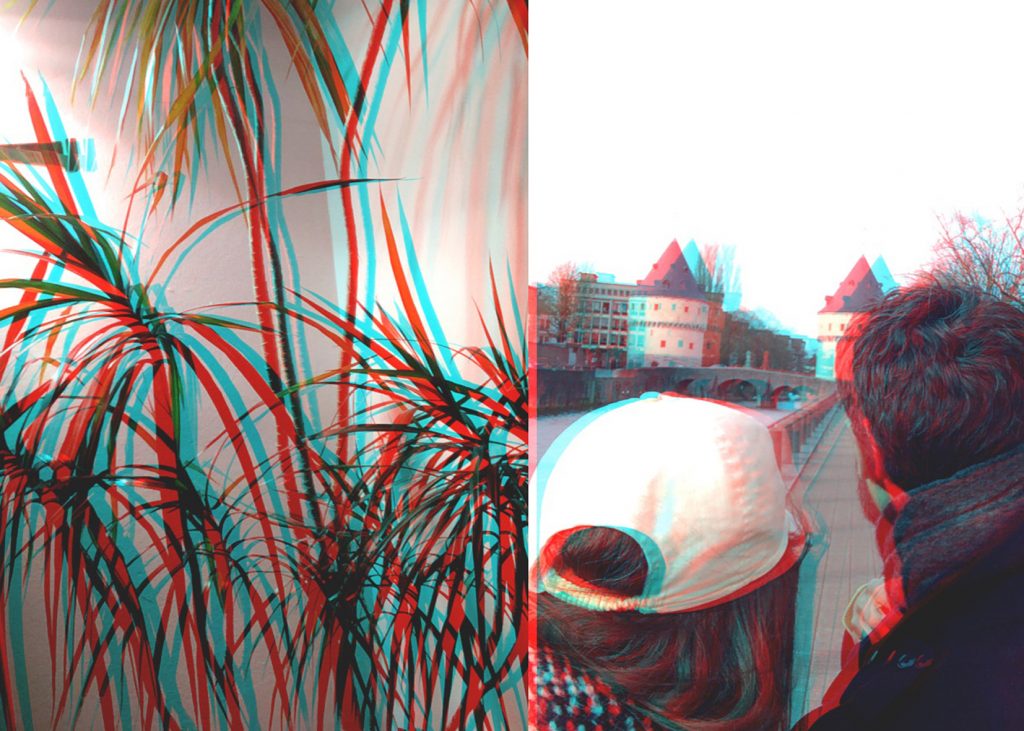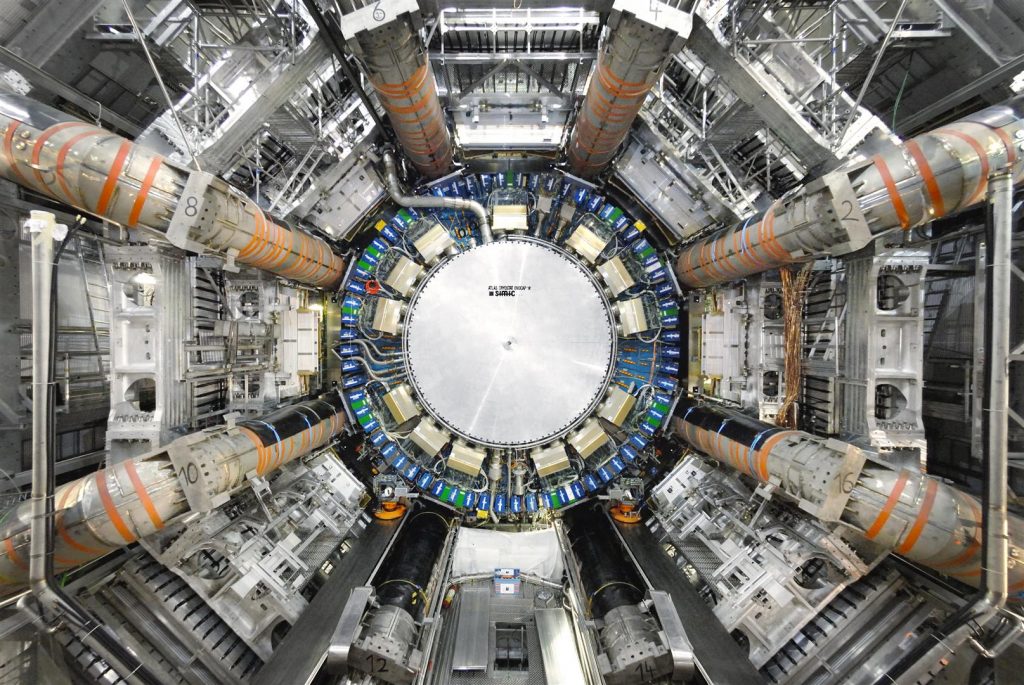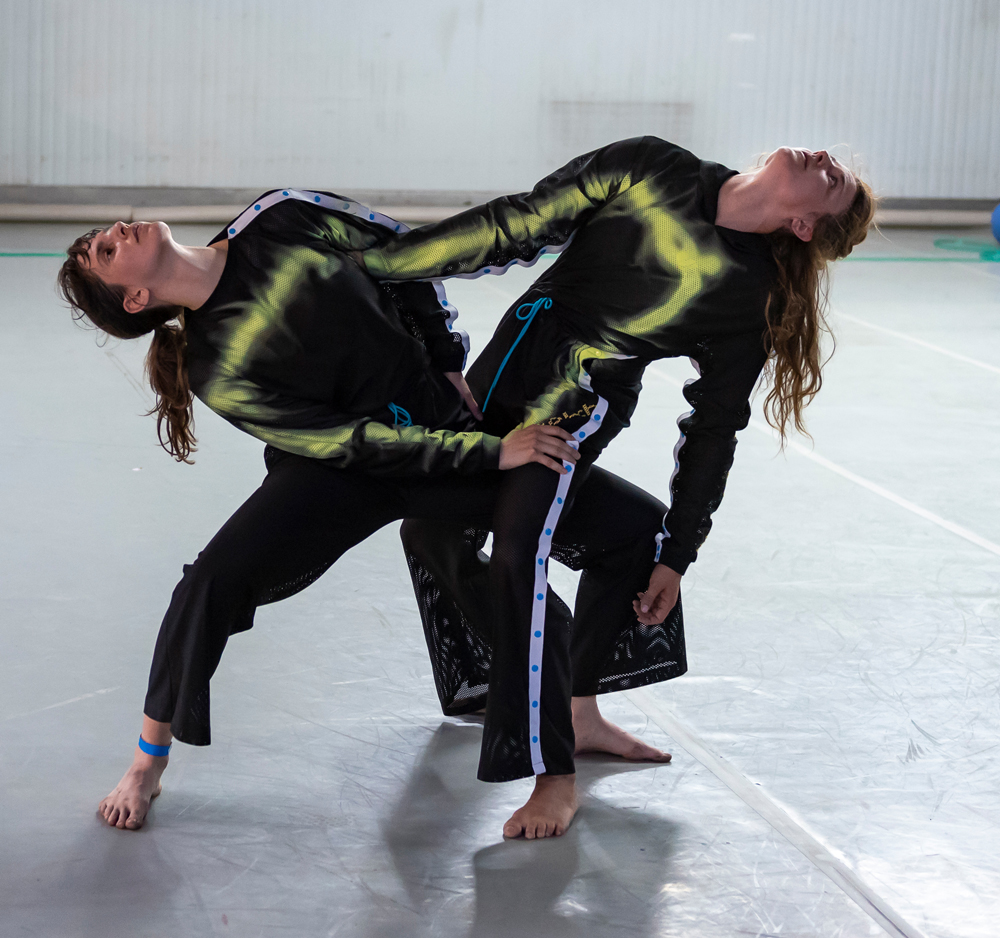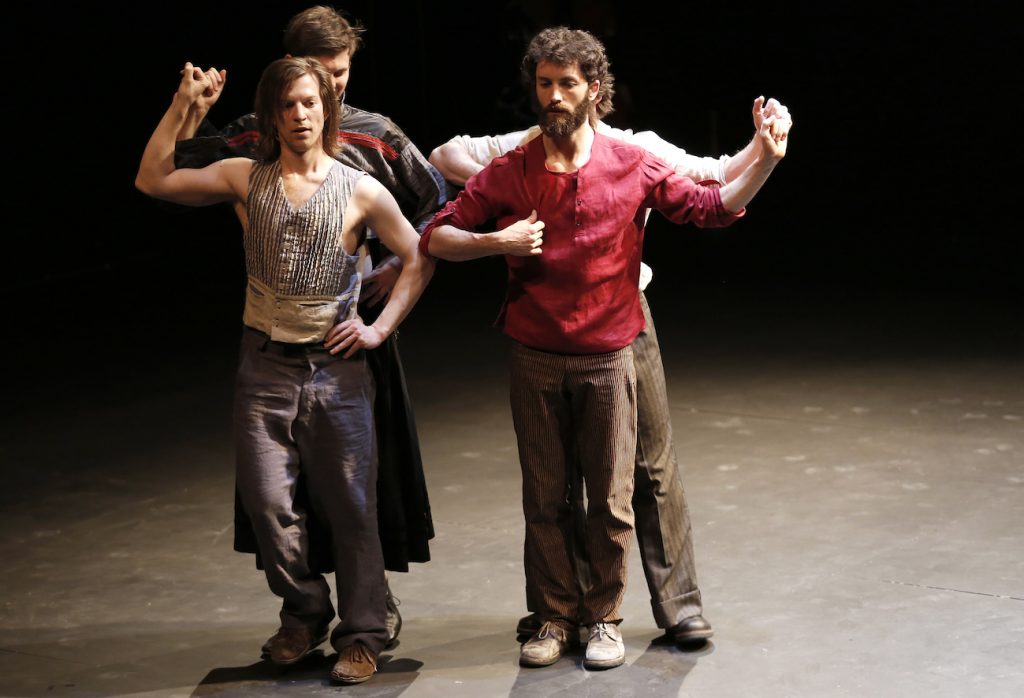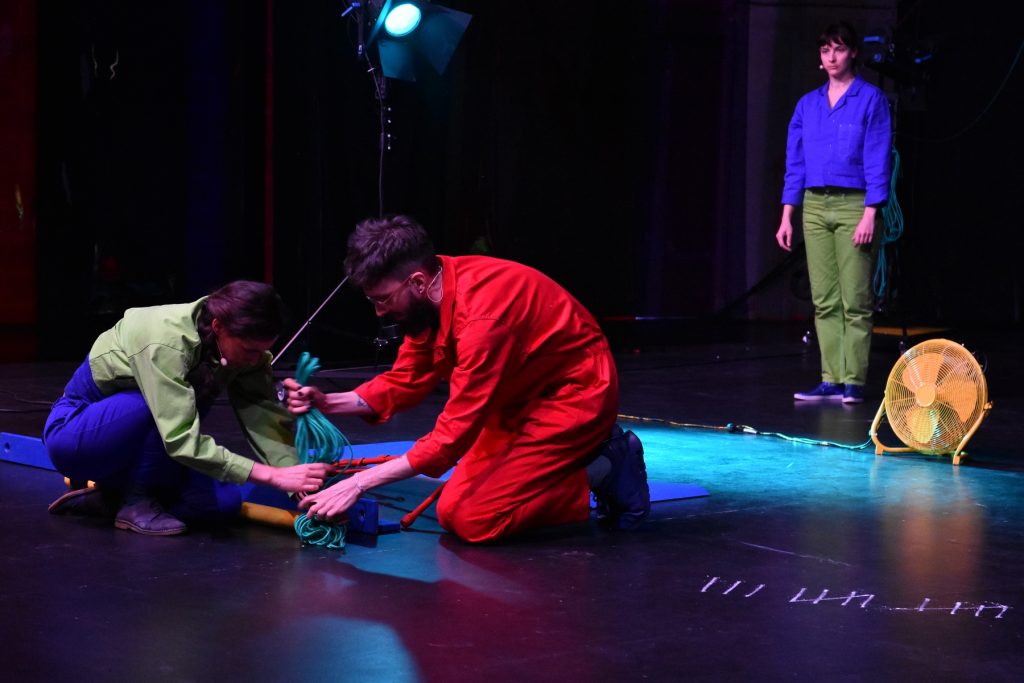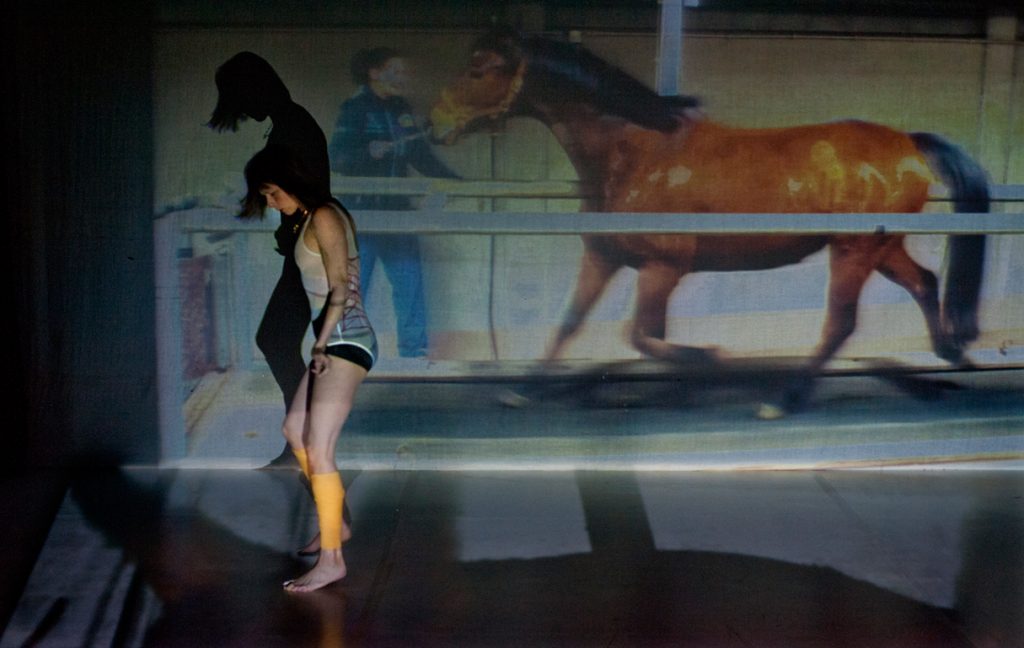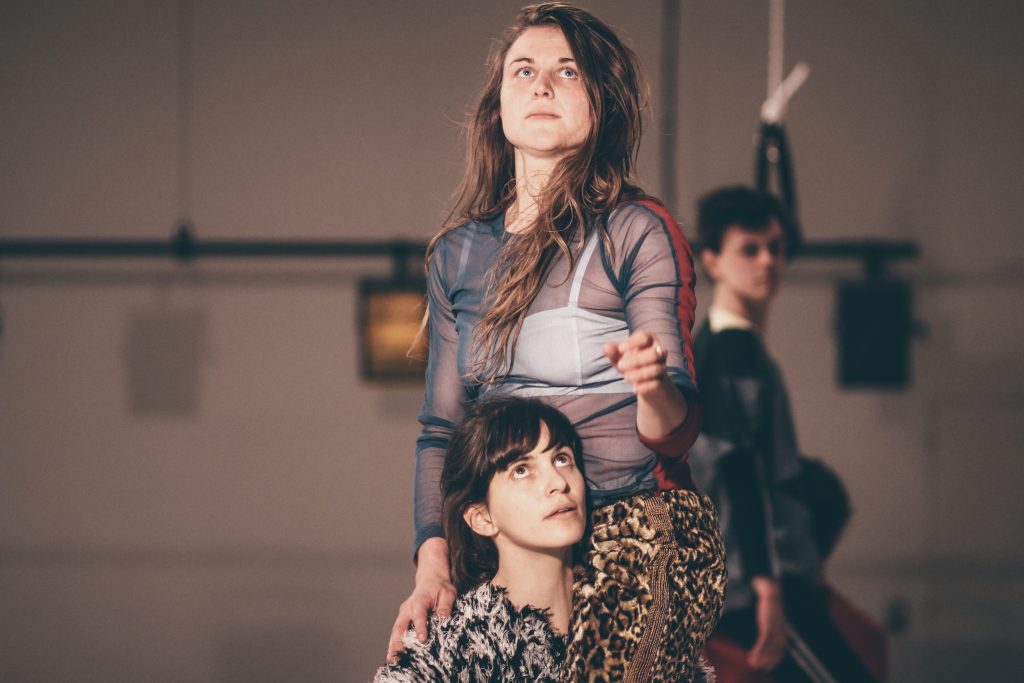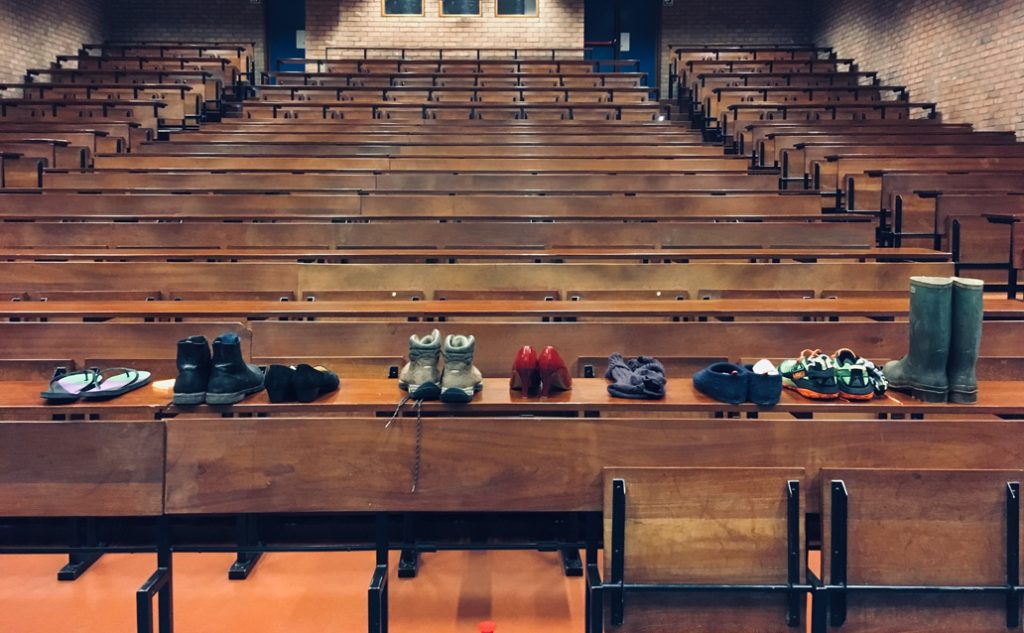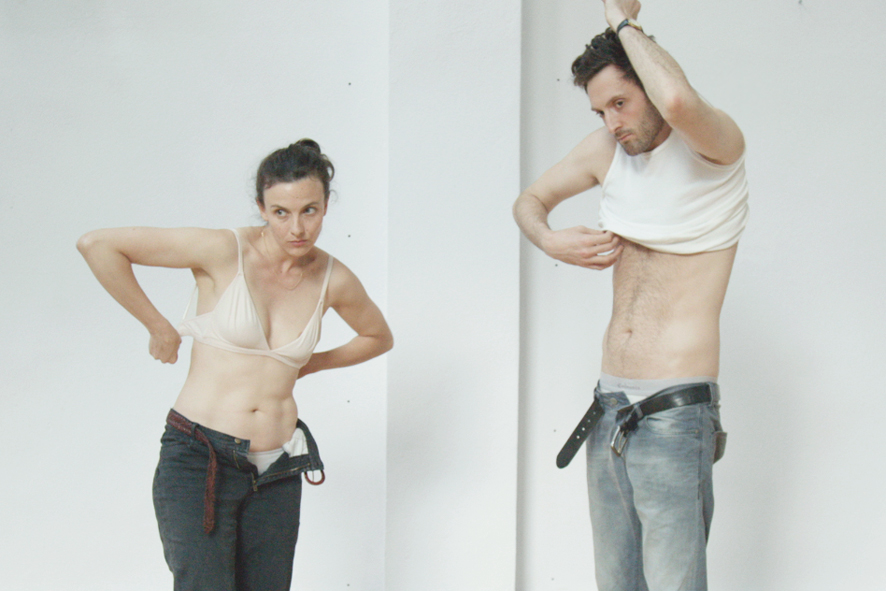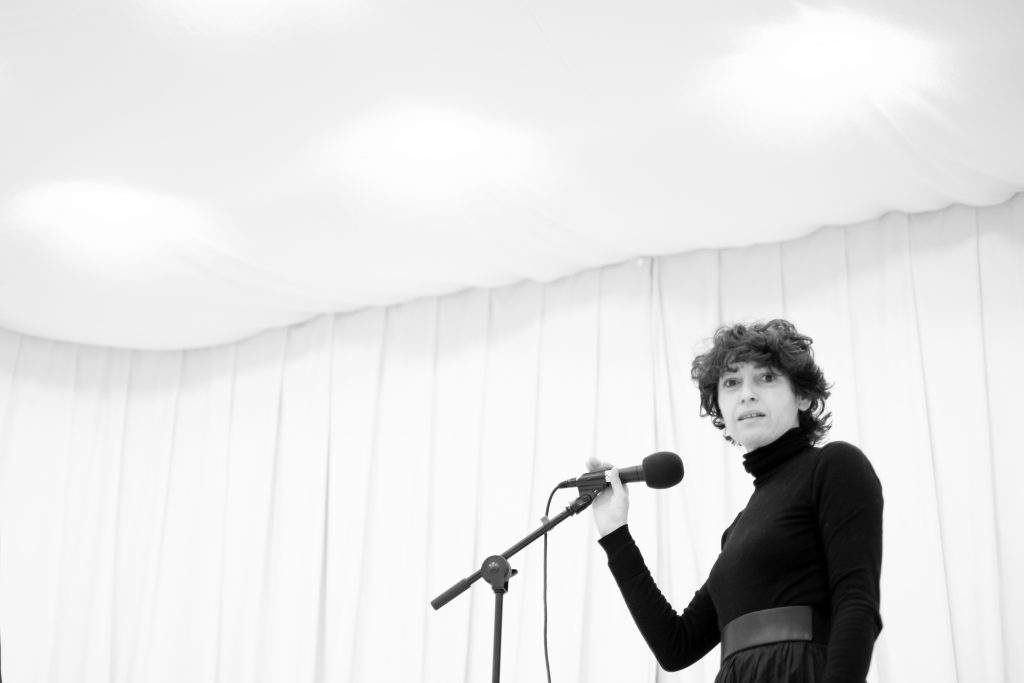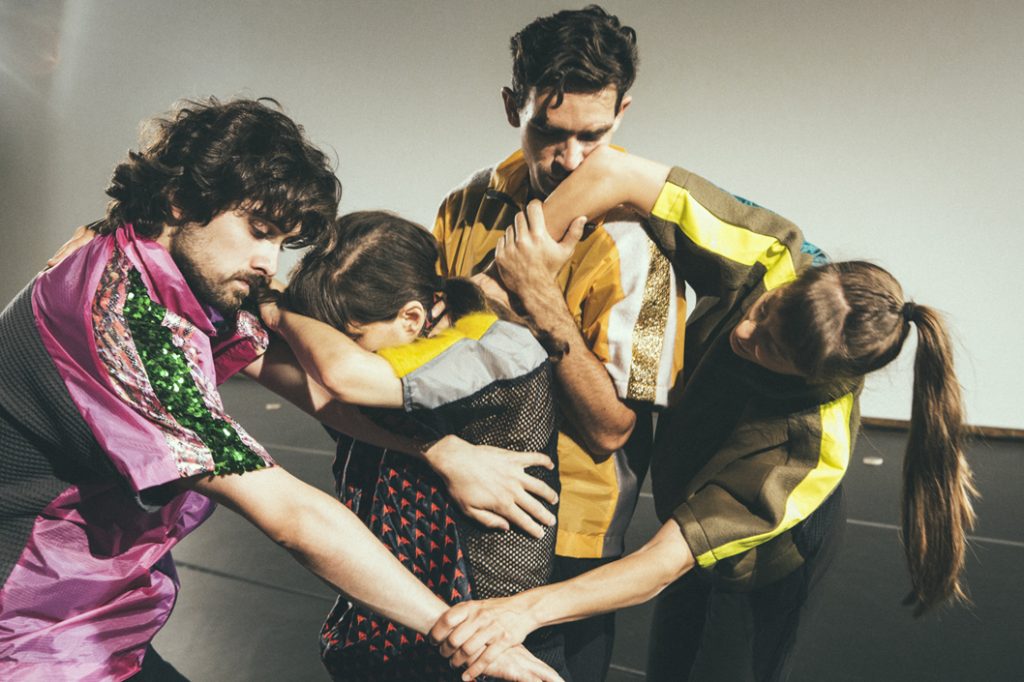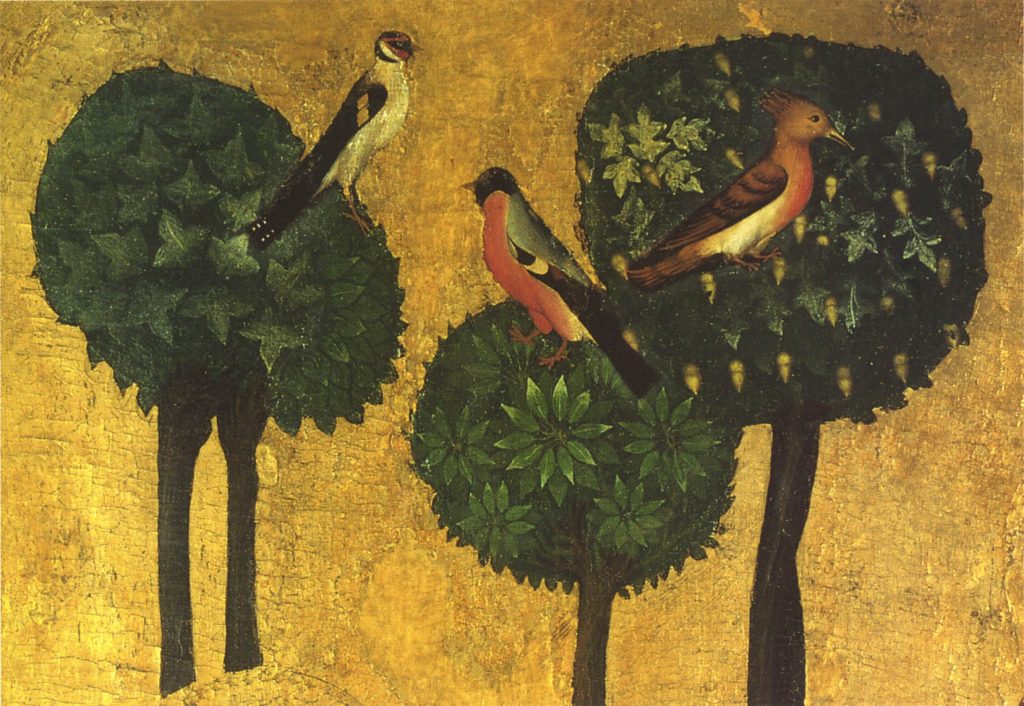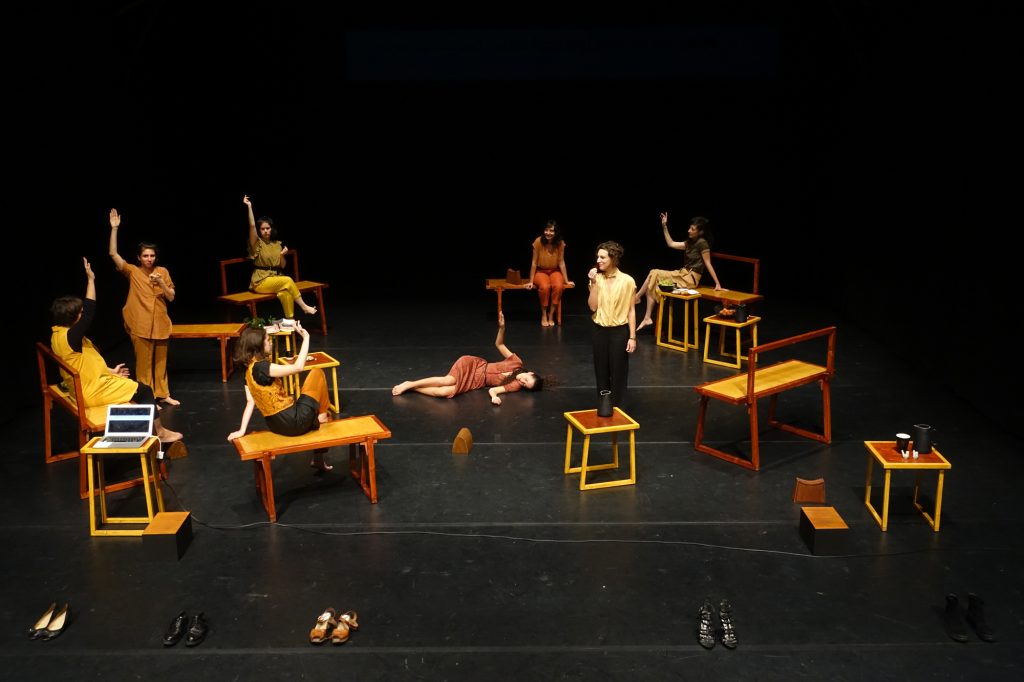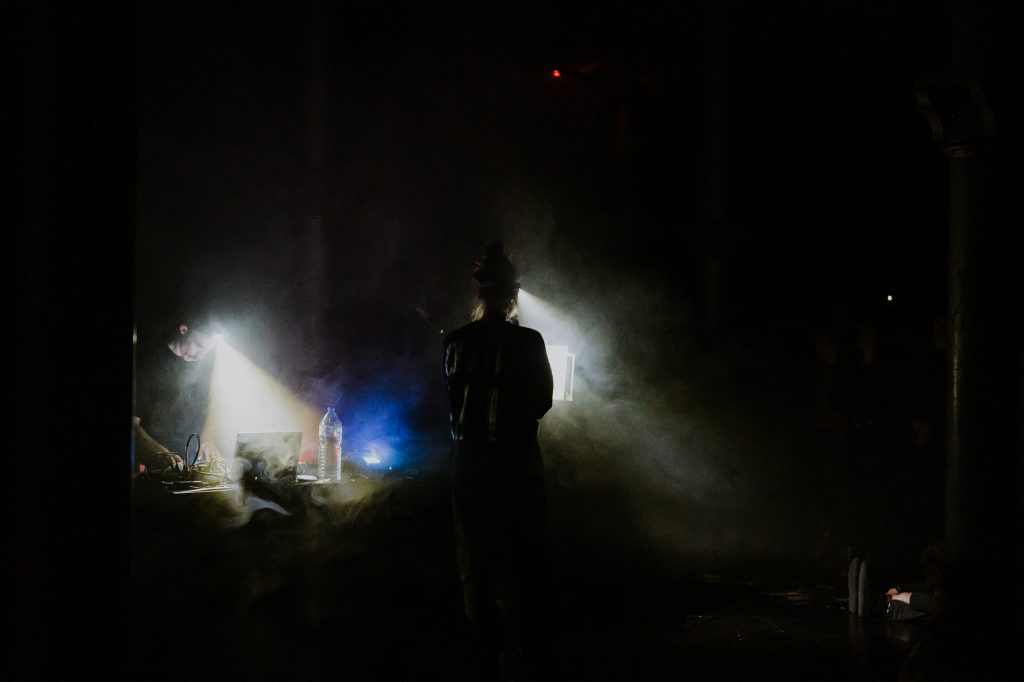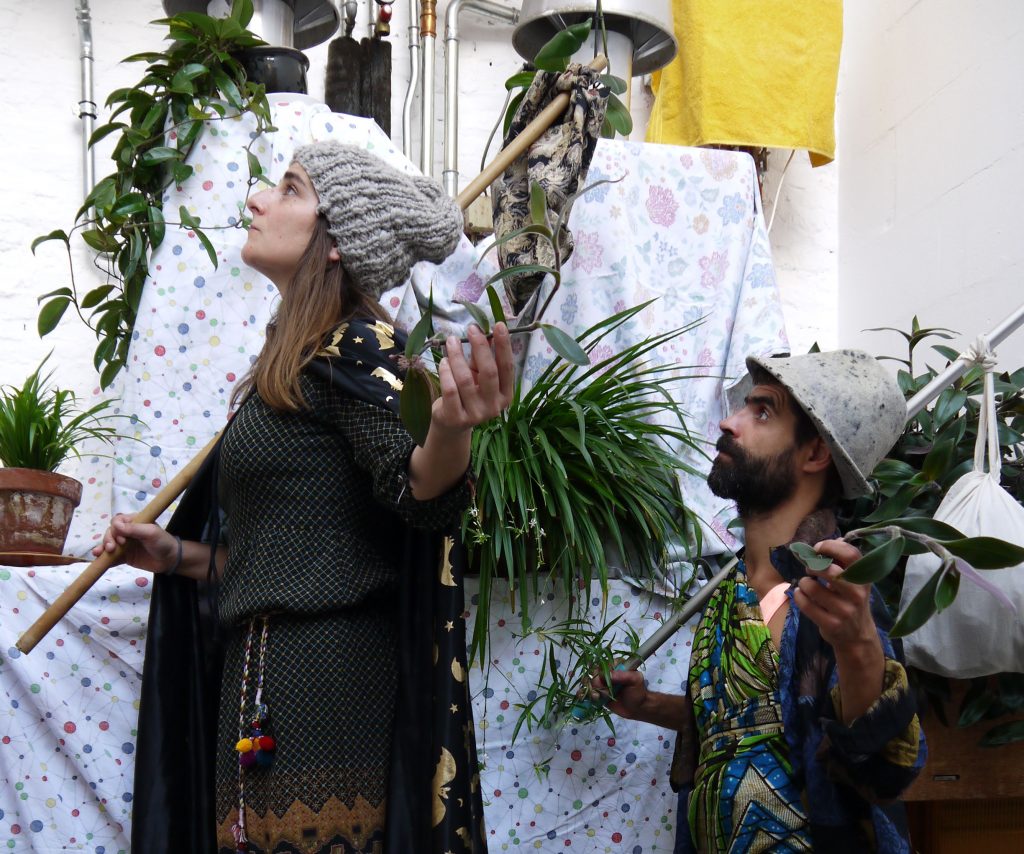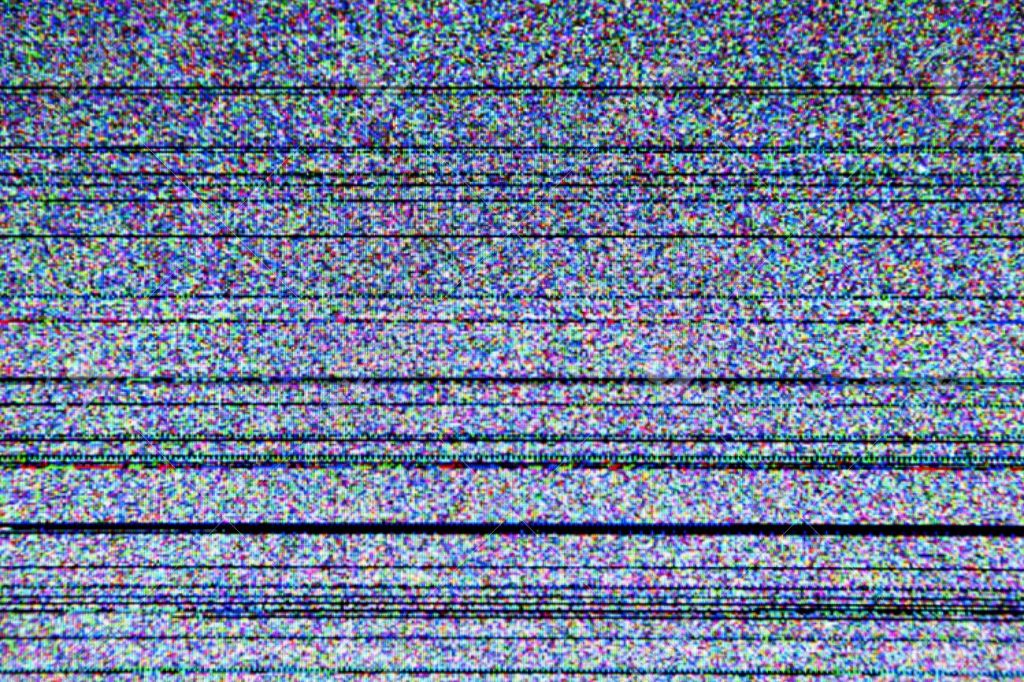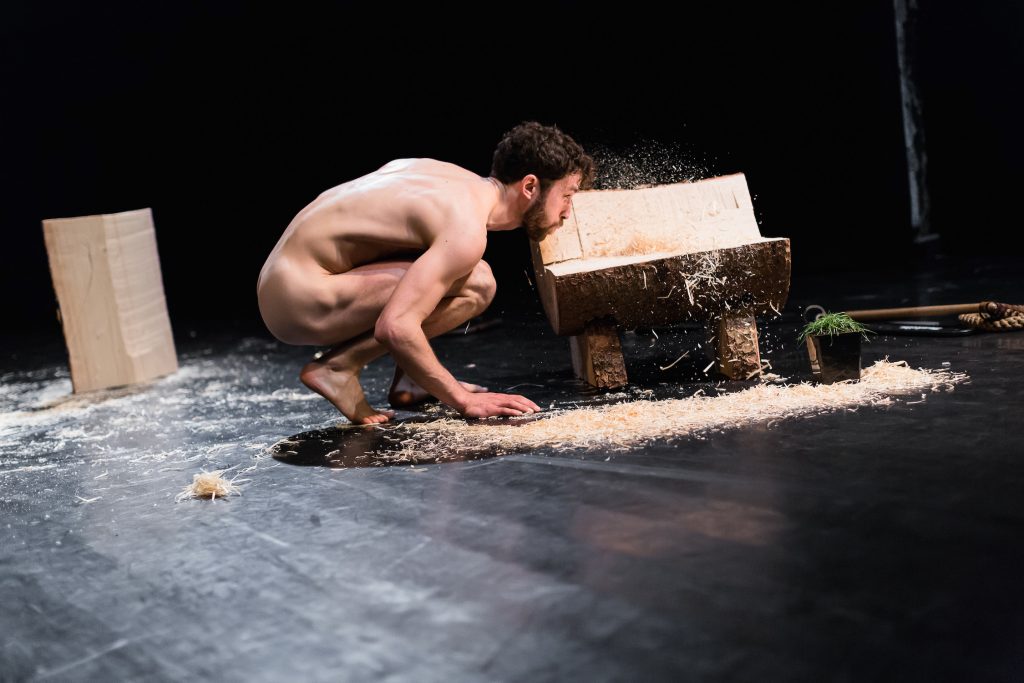Spectacles is a research by Sara Manente starting from the distance between language and experience, specifically the experience of dance and performance.
Agenda
Filter by artist
In Voicing Pieces, one’s own voice is staged to become the protagonist. In the intimacy of an isolated sound booth, guided by a simple score, the audience becomes spectator of their own voice.
Works of science fiction give us an insight into a future civilization by telling the adventures of one of its individual inhabitants. Some use for your broken clay pots, on the contrary, provides us with the code that rules the life of the society it imagines.
Meanwhile, is a work about bodies, architectures, and disasters. The performers are evolving in a set that could be an architectural model or installation. Constantly, they have to deal with a destruction’s threat on what they build. By playing with scales, the body within the space ranges from power to helplessness.
Meanwhile, is a work about bodies, architectures, and disasters. The performers are evolving in a set that could be an architectural model or installation. Constantly, they have to deal with a destruction’s threat on what they build. By playing with scales, the body within the space ranges from power to helplessness.
In Both, Two Tussing & Vanderbruggen examine the duet, the smallest unit of togetherness. The dance duet is a genre with a history. In their most familiar forms, duets reflect the range of possibilities for relating, which resonate within a certain cultural imaginary. In particular, they reveal common-sense attitudes towards who gets to move, how, and under what conditions.
Spectacles is a research by Sara Manente starting from the distance between language and experience, specifically the experience of dance and performance.
The focus of Sons of Sissy is the universe of traditions, folk dances and folk music from which the Upper Austrian country lad Simon Mayer originates.
New Measuring Rites is the story of a weird anthropological excursion into an environment called the Current Situation, a fluid space with indeterminate borders. In this unknown world, forces are felt, colors keep on changing, obstacles appear and disappear.
Spectacles is a research by Sara Manente starting from the distance between language and experience, specifically the experience of dance and performance.
In As We Were Moving Ahead Occasionally We Saw Brief Glimpses of Beauty, Gaëtan Rusquet explores the choreographic potential of (live) video editing and the perspective of the selfie. In a never-ending tracking shot, the arm operates as a steadycam creating a hypnotic loop.
In Both, Two Tussing & Vanderbruggen examine the duet, the smallest unit of togetherness. The dance duet is a genre with a history. In their most familiar forms, duets reflect the range of possibilities for relating, which resonate within a certain cultural imaginary. In particular, they reveal common-sense attitudes towards who gets to move, how, and under what conditions.
The focus of Sons of Sissy is the universe of traditions, folk dances and folk music from which the Upper Austrian country lad Simon Mayer originates.
Gallop (Biography of a Body) tells the bizarre story of the life cycle of a body. It is a chronically ill body that has reached a turning point after forty years, and often seems to have a life of its own. Its service fails and resistance loses.
Oh Magic wanders through the wonders of theatrical magic. It is that mysterious unnamable thing we sometimes have the chance to encounter in a piece. But, where does it come from and where does it take us? What fascinates us as a performer or as a spectator? Somewhere between freak and fascination, Simon Mayer and his performers seek for the answers both in technological manipulation and organic oracles.
Gallop (Biography of a Body) tells the bizarre story of the life cycle of a body. It is a chronically ill body that has reached a turning point after forty years, and often seems to have a life of its own. Its service fails and resistance loses.
Gallop (Biography of a Body) tells the bizarre story of the life cycle of a body. It is a chronically ill body that has reached a turning point after forty years, and often seems to have a life of its own. Its service fails and resistance loses.
In Voicing Pieces, one’s own voice is staged to become the protagonist. In the intimacy of an isolated sound booth, guided by a simple score, the audience becomes spectator of their own voice.
What does it mean to be together? In Mazing, five dancers are set in motion by the audience, creating visible networks of action which emerge from simple social negotiations. This gently destabilizing performance both challenges and strengthens notions of community, re- affirming the power of touch in the digital age.
The focus of Sons of Sissy is the universe of traditions, folk dances and folk music from which the Upper Austrian country lad Simon Mayer originates.
Tactile Quartet(s) is an interactive piece that builds on Vera Tussing’s previous explorations of dance, tactility, and the sensory engagement of the audience. Four musicians play the American Quartet by Dvořák, a piece written in the late 1800 and belonging to the romantic period in music history.
Oh Magic wanders through the wonders of theatrical magic. It is that mysterious unnamable thing we sometimes have the chance to encounter in a piece. But, where does it come from and where does it take us? What fascinates us as a performer or as a spectator? Somewhere between freak and fascination, Simon Mayer and his performers seek for the answers both in technological manipulation and organic oracles.
Can the money we all use on a daily basis, be held responsible for the disastrous state the world is in today? In other words, if it is true that “money rules the world”, are we then not entitled to make it accountable for what has happened to the world under its governance? Trials of Money approaches this somewhat candid statement with the seriousness of a court of justice.
Gallop (Biography of a Body) tells the bizarre story of the life cycle of a body. It is a chronically ill body that has reached a turning point after forty years, and often seems to have a life of its own. Its service fails and resistance loses.
What does it mean to be together? In Mazing, five dancers are set in motion by the audience, creating visible networks of action which emerge from simple social negotiations. This gently destabilizing performance both challenges and strengthens notions of community, re- affirming the power of touch in the digital age.
A Breath Cycle consist of an ever-changing corpus of performances who share ‘breathing’ as their main focus. Seven performances on breathing or wherein the breath takes a central role will be presented in A Breath Cycle. All of the performances are based on a protocol.
What does it mean to be together? In Mazing, five dancers are set in motion by the audience, creating visible networks of action which emerge from simple social negotiations. This gently destabilizing performance both challenges and strengthens notions of community, re- affirming the power of touch in the digital age.
What does it mean to be together? In Mazing, five dancers are set in motion by the audience, creating visible networks of action which emerge from simple social negotiations. This gently destabilizing performance both challenges and strengthens notions of community, re- affirming the power of touch in the digital age.
Tactile Quartet(s) is an interactive piece that builds on Vera Tussing’s previous explorations of dance, tactility, and the sensory engagement of the audience. Four musicians play the American Quartet by Dvořák, a piece written in the late 1800 and belonging to the romantic period in music history.
Several Belgium-based artists are invited to present their practice through talks, videos and (fragments of) their work and research. This encounter and exchange is created for programmers and professionals active in the performing arts field.
Can the money we all use on a daily basis, be held responsible for the disastrous state the world is in today? In other words, if it is true that “money rules the world”, are we then not entitled to make it accountable for what has happened to the world under its governance? Trials of Money approaches this somewhat candid statement with the seriousness of a court of justice.
This is a dance of touch. The work exists in the active, tactile, engaged negotiation between performer and audience – in their tacit agreement and understanding. Arranged in an ellipse, the audience themselves form the bounds of the theatrical space. This is a journey that, by definition, performer and audience discover and create together.
In Voicing Pieces, one’s own voice is staged to become the protagonist. In the intimacy of an isolated sound booth, guided by a simple score, the audience becomes spectator of their own voice.
Oh Magic wanders through the wonders of theatrical magic. It is that mysterious unnamable thing we sometimes have the chance to encounter in a piece. But, where does it come from and where does it take us? What fascinates us as a performer or as a spectator? Somewhere between freak and fascination, Simon Mayer and his performers seek for the answers both in technological manipulation and organic oracles.
Oh Magic wanders through the wonders of theatrical magic. It is that mysterious unnamable thing we sometimes have the chance to encounter in a piece. But, where does it come from and where does it take us? What fascinates us as a performer or as a spectator? Somewhere between freak and fascination, Simon Mayer and his performers seek for the answers both in technological manipulation and organic oracles.
Can the money we all use on a daily basis, be held responsible for the disastrous state the world is in today? In other words, if it is true that “money rules the world”, are we then not entitled to make it accountable for what has happened to the world under its governance? Trials of Money approaches this somewhat candid statement with the seriousness of a court of justice.
The focus of Sons of Sissy is the universe of traditions, folk dances and folk music from which the Upper Austrian country lad Simon Mayer originates.
Oh Magic wanders through the wonders of theatrical magic. It is that mysterious unnamable thing we sometimes have the chance to encounter in a piece. But, where does it come from and where does it take us? What fascinates us as a performer or as a spectator? Somewhere between freak and fascination, Simon Mayer and his performers seek for the answers both in technological manipulation and organic oracles.
Meanwhile, is a work about bodies, architectures, and disasters. The performers are evolving in a set that could be an architectural model or installation. Constantly, they have to deal with a destruction’s threat on what they build. By playing with scales, the body within the space ranges from power to helplessness.
The focus of Sons of Sissy is the universe of traditions, folk dances and folk music from which the Upper Austrian country lad Simon Mayer originates.
In Voicing Pieces, one’s own voice is staged to become the protagonist. In the intimacy of an isolated sound booth, guided by a simple score, the audience becomes spectator of their own voice.
In Voicing Pieces, one’s own voice is staged to become the protagonist. In the intimacy of an isolated sound booth, guided by a simple score, the audience becomes spectator of their own voice.
In Voicing Pieces, one’s own voice is staged to become the protagonist. In the intimacy of an isolated sound booth, guided by a simple score, the audience becomes spectator of their own voice.
What does nature say? To find out, Myriam Van Imschoot visited a zoo, used a tuning fork to listen to a motorway, discovered on walks in the woods birds that sound like chainsaws or can imitate the ringtones of mobile phones, saw crocodiles in Australia but couldn’t hear them…
Can the money we all use on a daily basis, be held responsible for the disastrous state the world is in today? In other words, if it is true that “money rules the world”, are we then not entitled to make it accountable for what has happened to the world under its governance? Trials of Money approaches this somewhat candid statement with the seriousness of a court of justice.
Oh Magic wanders through the wonders of theatrical magic. It is that mysterious unnamable thing we sometimes have the chance to encounter in a piece. But, where does it come from and where does it take us? What fascinates us as a performer or as a spectator? Somewhere between freak and fascination, Simon Mayer and his performers seek for the answers both in technological manipulation and organic oracles.
Meanwhile, is a work about bodies, architectures, and disasters. The performers are evolving in a set that could be an architectural model or installation. Constantly, they have to deal with a destruction’s threat on what they build. By playing with scales, the body within the space ranges from power to helplessness.
An Imaginary Symposium is a live experiment on common thinking. Bringing together ancient Greek modes of sociability and artificial intelligence, it attempts to reactivate how we reflect and imagine in common.
The focus of Sons of Sissy is the universe of traditions, folk dances and folk music from which the Upper Austrian country lad Simon Mayer originates.
The focus of Sons of Sissy is the universe of traditions, folk dances and folk music from which the Upper Austrian country lad Simon Mayer originates.
An Imaginary Symposium is a live experiment on common thinking. Bringing together ancient Greek modes of sociability and artificial intelligence, it attempts to reactivate how we reflect and imagine in common.
An Imaginary Symposium is a live experiment on common thinking. Bringing together ancient Greek modes of sociability and artificial intelligence, it attempts to reactivate how we reflect and imagine in common.
Critical Techno is a trance lecture dance meditation — a two-hour collective journey in-between listening, dancing, words, sounds, beats, sweat, constellations, and bodies in space towards an unknown destination.
Meanwhile, is a work about bodies, architectures, and disasters. The performers are evolving in a set that could be an architectural model or installation. Constantly, they have to deal with a destruction’s threat on what they build. By playing with scales, the body within the space ranges from power to helplessness.
Verein zur Aufhebung des Notwendigen is a dinner and it is about democracy. Not democracy as institutional engineering for mass organisation, but democracy as something we internalize, as individuals, at the level of our day to day existence. It is about democracy as the realisation of our individual and collective desires.
For their project This place, Marcos Simoes and Sara Manente invite an “artistic couple” to share for two weeks a working space and a number of practices. The project consists of seven variations with seven different couples. By doing so, This place intends to keep on ‘displacing’ itself, its proposal, its performativity and its context. The project consists of every single as well as all variations together.
Verein zur Aufhebung des Notwendigen is a dinner and it is about democracy. Not democracy as institutional engineering for mass organisation, but democracy as something we internalize, as individuals, at the level of our day to day existence. It is about democracy as the realisation of our individual and collective desires.
There are senders and receivers and there is an audience too.
There is “belief” and there is “make belief” and there is “magic” too.
We create the magic by creating the rules for it to happen.
We empower an object, a person, a situation through speculation and prediction.
Like an “Experimental Magic” without magicians.
Oh Magic wanders through the wonders of theatrical magic. It is that mysterious unnamable thing we sometimes have the chance to encounter in a piece. But, where does it come from and where does it take us? What fascinates us as a performer or as a spectator? Somewhere between freak and fascination, Simon Mayer and his performers seek for the answers both in technological manipulation and organic oracles.
This work springs from the desire to develop a dance performance within the habitat of an already existing dance style, taking the exploration of its intrinsic complexity as the departure point for the elaboration of a choreographic object. Farmer Train Swirl – Étude is a kinesthetic and subjective investigation of the field of House dance – a style born in the clubs of Chicago & New York in the early eighties.
This is a dance of touch. The work exists in the active, tactile, engaged negotiation between performer and audience – in their tacit agreement and understanding. Arranged in an ellipse, the audience themselves form the bounds of the theatrical space. This is a journey that, by definition, performer and audience discover and create together.
Can the money we all use on a daily basis, be held responsible for the disastrous state the world is in today? In other words, if it is true that “money rules the world”, are we then not entitled to make it accountable for what has happened to the world under its governance? Trials of Money approaches this somewhat candid statement with the seriousness of a court of justice.
SunBengSitting is a piece straddling yodeling, folk dance and contemporary dance, a trip to the past and a playful, humorous search for identity.
SunBengSitting is a piece straddling yodeling, folk dance and contemporary dance, a trip to the past and a playful, humorous search for identity.
SunBengSitting is a piece straddling yodeling, folk dance and contemporary dance, a trip to the past and a playful, humorous search for identity.
SunBengSitting is a piece straddling yodeling, folk dance and contemporary dance, a trip to the past and a playful, humorous search for identity.
